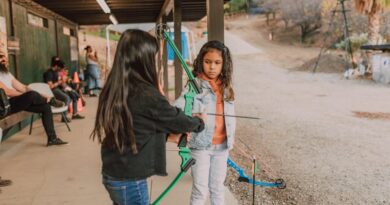Essential Tips for Sustainable Bowhunting
For nature lovers and outdoor enthusiasts, bowhunting offers a unique and challenging way to connect with the wilderness. However, as with any activity that involves hunting, it is crucial to prioritize sustainability and ethical practices to ensure the long-term health of wildlife populations and ecosystems. In this comprehensive guide, we will delve into essential tips for sustainable bowhunting, exploring key strategies, techniques, and principles that can help hunters minimize their impact on the environment while enjoying this age-old tradition.
The Importance of Sustainable Bowhunting

Bowhunting has a rich history dating back thousands of years, with ancient civilizations relying on bows and arrows for hunting and survival. In today’s modern world, bowhunting continues to be a popular recreational activity for many individuals, offering a deeper connection to nature and a more challenging hunting experience compared to firearms.
However, the increasing pressures of human population growth, habitat loss, and climate change have put wildlife populations at risk. As responsible stewards of the environment, bowhunters have a crucial role to play in conservation efforts. By adopting sustainable practices and following ethical guidelines, bowhunters can help maintain healthy wildlife populations, preserve natural habitats, and contribute to the overall well-being of ecosystems.
Understanding Sustainable Bowhunting

Sustainable bowhunting is about striking a balance between the needs of hunters and the needs of wildlife and ecosystems. It involves making informed decisions based on scientific knowledge, ethical considerations, and a deep respect for nature. Sustainable bowhunters aim to harvest game animals in a way that ensures the long-term viability of populations, minimizes suffering, and respects the natural order of ecosystems.
Key principles of sustainable bowhunting include:
1. Respect for Wildlife

Respecting wildlife is a fundamental aspect of sustainable bowhunting. It involves understanding the behavior and biology of game animals, as well as their roles within the ecosystem. Bowhunters should strive to make clean and ethical kills, minimizing suffering for the animals they pursue. This includes practicing shot placement, using proper equipment, and honing their skills to ensure quick and humane kills.
Additionally, sustainable bowhunters should always follow local regulations and guidelines regarding hunting seasons, bag limits, and species protection. By respecting wildlife and hunting laws, bowhunters can help maintain balanced populations and healthy ecosystems.
2. Conservation of Habitat

Conserving habitat is essential for the long-term survival of wildlife species. Sustainable bowhunters should advocate for the protection of natural habitats, including forests, wetlands, and grasslands that provide critical resources for game animals. By supporting conservation efforts and land preservation initiatives, bowhunters can help ensure that future generations will have the opportunity to enjoy hunting in healthy and diverse ecosystems.
Furthermore, bowhunters can contribute to habitat conservation by practicing responsible land stewardship. This includes minimizing their impact on the environment, avoiding sensitive areas, and participating in habitat restoration projects. By taking care of the land they hunt on, bowhunters can help create sustainable habitats for wildlife and promote biodiversity.
3. Ethical Behavior
Ethical behavior is a cornerstone of sustainable bowhunting. Bowhunters should hold themselves to high standards of conduct, treating wildlife, fellow hunters, and the environment with respect and integrity. This includes following fair chase principles, practicing good sportsmanship, and upholding ethical hunting practices at all times.
Ethical bowhunters should also strive to make ethical decisions in the field, such as passing on marginal shots, respecting property rights, and reporting violations of hunting regulations. By demonstrating ethical behavior, bowhunters can promote a positive image of hunting and inspire others to embrace sustainable practices.
4. Education and Training
Education and training are essential components of sustainable bowhunting. Bowhunters should continuously seek out opportunities to improve their knowledge and skills, including attending workshops, seminars, and training sessions. By staying informed about the latest hunting techniques, regulations, and conservation practices, bowhunters can become more effective and responsible hunters.
Furthermore, education can help bowhunters develop a deeper appreciation for nature and wildlife, fostering a sense of stewardship and conservation ethics. By sharing their knowledge with others and mentoring new hunters, experienced bowhunters can help ensure the future of sustainable hunting practices.
5. Community Involvement
Community involvement is another important aspect of sustainable bowhunting. Bowhunters should actively engage with their local hunting community, conservation organizations, and wildlife agencies to promote sustainable hunting practices and conservation efforts. By participating in conservation projects, volunteering for habitat improvement initiatives, and advocating for wildlife protection, bowhunters can make a positive impact on the environment and contribute to the larger conservation community.
Community involvement also provides opportunities for bowhunters to connect with like-minded individuals, share experiences, and support each other in their hunting pursuits. By building strong relationships within the hunting community, bowhunters can work together to promote ethical hunting practices and sustainable conservation efforts.
Expert Opinions
According to renowned wildlife biologist and bowhunting expert, Dr. James Johnson, “Sustainable bowhunting is not just a responsibility, but a privilege. As hunters, we have the unique opportunity to immerse ourselves in the natural world and experience the thrill of the chase. However, with that privilege comes a duty to hunt ethically, conserve habitats, and respect wildlife. By following sustainable practices, bowhunters can enjoy the sport of hunting while contributing to the long-term health of ecosystems.”
Common Misconceptions
One common misconception about sustainable bowhunting is that it is only about harvesting game animals. While hunting is a central aspect of the sport, sustainable bowhunting encompasses a much broader set of principles and practices. It involves a deep respect for nature, ethical conduct in the field, and a commitment to conservation and habitat protection. By dispelling misconceptions and promoting a holistic understanding of sustainable bowhunting, we can encourage more hunters to embrace sustainable practices and become stewards of the environment.
Conclusion
To wrap things up, sustainable bowhunting is not just about harvesting game animals; it’s about embracing a way of life that values respect, ethics, and conservation. By following essential tips for sustainable bowhunting and incorporating these principles into their hunting practices, bowhunters can contribute to the long-term health of wildlife populations and ecosystems. Whether you’re a seasoned bowhunter or new to the sport, remember that every action you take in the field has an impact on the natural world. By hunting sustainably, you can ensure that future generations will have the opportunity to enjoy the thrill of the hunt while preserving the beauty and diversity of our natural world.




